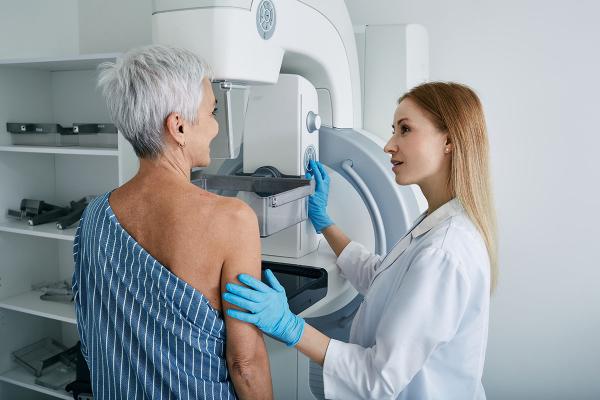Software Tool Guides Breast Cancer Care
IRP’s Jinani Jayasekera Hopes to Help Women Make Medical Decisions

IRP researchers are developing software tools that can help women decide what measures to take to lower their risk for breast cancer.
The women in our lives deserve flowers and thanks on Mother’s Day, but they also deserve attention to their well-being. This past Sunday, May 12, marked the start of Women’s Health Week, a time to reflect on the decisions women make to look after their own health.
For instance, breast cancer treatments are something no woman wants to think about, but every year about 240,000 newly diagnosed women in the U.S. face high-stakes decisions about what medical interventions to pursue. IRP Stadtman investigator Jinani Jayasekera, Ph.D., and her colleagues in the IRP’s Health Equity and Decision Sciences (HEADS) lab develop software-based clinical decision-making tools to help women and their doctors assess and address their health risks when choosing treatments.
“When you look at controlling cancer, you can address it at multiple stages, and there are various strategies ranging from prevention and early detection to treatment,” Dr. Jayasekera says. “We want to help women understand the options available to them all along the way, and also, of course, help reduce breast cancer death overall and help women live better and longer lives.”
Recently, new findings from a study published in 2017 prompted Dr. Jayasekera’s team to take on a new project in pursuit of that goal. The study, which used data from multiple clinical trials focused on breast cancer, found that even though estrogen receptor-positive breast cancer generally has a better prognosis than other types of breast cancer, patients in remission have a roughly 3 percent annual chance of seeing their cancer return during the two decades after remission. That’s a long time to be living under threat of another bout with the disease. In light of this new evidence, Dr. Jayasekera’s team re-evaluated the benefits of preventing breast cancer in women who are at high risk for it based on characteristics like their family history and age.
Several risk-reducing drugs like tamoxifen and estrogen blockers are currently recommended to lower the risk of breast cancer in high-risk women, but those women don’t often use them. While the reasons for this under-use aren’t clear, the lack of knowledge about the drugs’ long-term effects, potentially serious side effects like endometrial cancer, and the lack of clear indicators that they’re working likely play a role.

Mammograms and certain medications can help lower women's risk of breast cancer, but all those options have pros and cons that need to be considered.
“Many women and their clinicians think that the harms of risk-reducing drugs will outweigh their potential benefits,” Dr. Jayasekara says. “By providing personalized data and quantifying the net balance of the long-term benefits and harms of risk-reducing drugs, we thought we could help clinicians talk about risk management with high-risk women, and most importantly, help these women select the best strategy to reduce their risk of dying from breast cancer. So that's what we did.”
Dr. Jayasekara and her colleagues built a computer program that crunches data about known risk factors for breast cancer and compares them with a patient’s personal characteristics. The software then processes patient information and provides a personalized summary of the pros and cons of different breast cancer prevention and screening options based on those characteristics. 1
Now that they have a computer model that can help patients make decisions about breast cancer prevention and screening, Dr. Jayaskera and her colleagues are designing an easy-to-use computer interface patients and clinicians can use to interact with the software tool. While that’s in the works, the team is also busy creating similar decision-making tools for other types of medical treatments and health-related behaviors.

Dr. Jinani Jayasekera
“Right now, we’re collaborating with clinicians and breast cancer survivors to develop a clinical decision tool that could provide personalized recommendations for physical activity to breast cancer survivors,” Dr. Jayasekara says. “Our primary goal is to make sure that the new tool will have broader uses among breast cancer survivors from backgrounds that have been historically underserved and underrepresented in physical activity research.”
Her team recently finished a round of focus groups with breast cancer survivors as part of this research, which highlighted some unexpected concerns when it came to the types of questions the IRP team planned to incorporate into the computer program. For instance, asking a lot of questions about previous treatments could be re-traumatizing for some breast cancer survivors.
"As researchers, I think it is really important to constantly remind ourselves about the humanistic aspect of research,” Dr. Jayasekara says. “Recently, our team was planning on collecting detailed information on treatment history from breast cancer survivors. The women told us, ‘When you ask me so much about my breast cancer, you take me back to a really difficult time in my life.’ For me, that was a pivotal moment in my research career. Research rigor must go hand in hand with empathy and care, especially when you are connecting with patients.”
Ultimately, Dr. Jayasekara hopes to develop a full suite of personalized, online clinical decision-making tools that address issues and questions that come up across the entire breast cancer care continuum, from predicting risk to choosing treatments to managing health after treatment. Her team is especially dedicated to considering problems that affect underserved and underrepresented women in cancer research.
“Our agenda, in a sense, is to use these tools to address systemic barriers that drive breast cancer disparities in the U.S.,” Dr. Jayasekara says. “We hope to use these tools to dissect issues that drive delayed treatment and lack of access to resources, and ultimately identify patients who need help achieving better health outcomes.”
Subscribe to our weekly newsletter to stay up-to-date on the latest breakthroughs in the NIH Intramural Research Program.
References:
[1] Jayasekara J, Zhao A, Schechter C, Lowry K, Yeh JM, Schwartz MD, O’Neill S, Wemli KJ, Stout N, Mandelblatt J, Kurian AW, Isaacs C. Reassessing the benefits and harms of risk-reducing medication considering the persistent risk of breast cancer mortality in estrogen receptor-positive breast cancer. J. Clin. Oncol. 2022 Dec 1; 41(4):859-870. doi: 10.1200/JCO.22.01342.
Related Blog Posts
This page was last updated on Wednesday, May 15, 2024
